Peristaltic pumps have become an integral part of various industries, including pharmaceuticals, due to their unique design and functions. We will explore the different types of peristaltic pumps, their applications in the pharmaceutical industry, and the significance of the variable speed capabilities of these pumps.

Peristaltic Pump Types: Tailored to Different Needs
Peristaltic pumps are known for their gentle pumping action, which makes them suitable for handling sensitive fluids and delicate substances. Here are some common types of peristaltic pumps:
- Tube pump: Tube pump is the most basic kind of peristaltic pump. They consist of a flexible tube that is squeezed by a rotating roller or shoe, creating a peristaltic motion that pushes liquid through the tube.
- Hose pumps: Hose pumps are similar to tube pumps, but use reinforced hoses instead of tubes. Reinforced hoses provide additional strength and durability, making hose pumps suitable for handling abrasive or viscous fluids.
- OEM pumps: Original Equipment Manufacturer (OEM) pumps are designed for integration into specific equipment or systems. These pumps are often customized to meet the unique requirements of the pharmaceutical industry, such as compact size, precise flow control, and compatibility with sterile environments.
Peristaltic Pumps Pharmaceutical : Precise and Contamination-Free Fluid Transfer
The pharmaceutical industry requires precise and contamination-free fluid transfer for various applications, such as drug manufacturing, research, and development. Peristaltic pumps offer several advantages in this regard:
- Sterility: Peristaltic pumps can be easily sterilized to ensure the integrity of the fluid being transported. The liquid only comes into contact with the pipe, eliminating the risk of cross-contamination.
- Precise dosing: Peristaltic pumps provide accurate and consistent dosing, making them ideal for applications where precise control of fluid volume is required. This is crucial in pharmaceutical production, where even small changes can affect product quality.
- Compatibility: Peristaltic pumps are compatible with a variety of fluids, including corrosive chemicals, viscous solutions, and sensitive pharmaceutical compounds. The hoses used in these pumps can be selected based on the specific fluid being delivered to ensure compatibility and prevent any adverse reactions.
Peristaltic Pump Pharmaceutical Application
Peristaltic pumps are commonly used in the pharmaceutical industry due to their ability to provide accurate and precise fluid transfer without contamination. Here are some key applications of peristaltic pumps in the pharmaceutical field:
- Drug Manufacturing and Processing: Peristaltic pumps are used in various stages of drug manufacturing and processing. They can be employed for transferring raw materials, active pharmaceutical ingredients (APIs), and excipients during formulation and compounding processes. Peristaltic pumps offer gentle handling of sensitive fluids and minimize the risk of contamination or degradation.
- Bioprocessing and Cell Culture: In biopharmaceutical production, peristaltic pumps are utilized for transferring and dosing cell culture media, buffers, and reagents. The gentle pumping action of peristaltic pumps helps maintain the viability and integrity of cells and delicate biomolecules. These pumps are often used in bioreactors, fermenters, and other bioprocessing equipment.
- Filling and Packaging: Peristaltic pumps are suitable for precise filling and packaging of pharmaceutical products. They can be used for accurately dispensing liquid medications, vaccines, or other pharmaceutical formulations into vials, syringes, or bottles. Peristaltic pumps ensure consistent dosage volumes and minimize the risk of cross-contamination.
- Laboratory and Research Applications: Peristaltic pumps are commonly found in pharmaceutical research and development laboratories. They are used for precise and controlled delivery of reagents, solvents, and samples in various analytical instruments, such as liquid chromatography systems, spectrophotometers, and dissolution testers. Peristaltic pumps enable accurate dosing and minimize sample loss or contamination.
Peristaltic Pump Speed: Enhancing Efficiency and Process Control
Peristaltic pump speed capabilities are a significant feature of modern peristaltic pumps, allowing for greater control over the pumping process. Here’s how variable speed capabilities benefit the pharmaceutical industry:
- Flow control: Variable speed peristaltic pumps provide precise flow control, allowing drugmakers to adjust the pumping speed to their specific requirements. This flexibility is particularly useful when dealing with different viscosities or when dosing needs to be adjusted during manufacturing.
- Gentle fluid handling: The ability to adjust the speed of the peristaltic pump ensures gentle fluid handling and minimizes the risk of shearing or damaging sensitive pharmaceutical compounds. This is essential to maintaining the integrity and effectiveness of medicines and other medicines.
- Process optimization: Variable speed peristaltic pumps promote process optimization by allowing drugmakers to fine-tune pumping parameters. This optimization can increase efficiency, reduce waste, and increase overall productivity.
Peristaltic pumps, with their various types and variable speed capabilities, have become indispensable in the pharmaceutical industry. These pumps offer precise and contamination-free fluid transfer, ensuring the integrity and quality of pharmaceutical products. With the ability to adjust pumping speed, peristaltic pumps provide enhanced process control, gentle fluid handling, and optimization opportunities. As the pharmaceutical industry continues to advance, peristaltic pumps will play a crucial role in meeting the industry’s evolving needs for accurate dosing, sterility, and efficient fluid transfer.